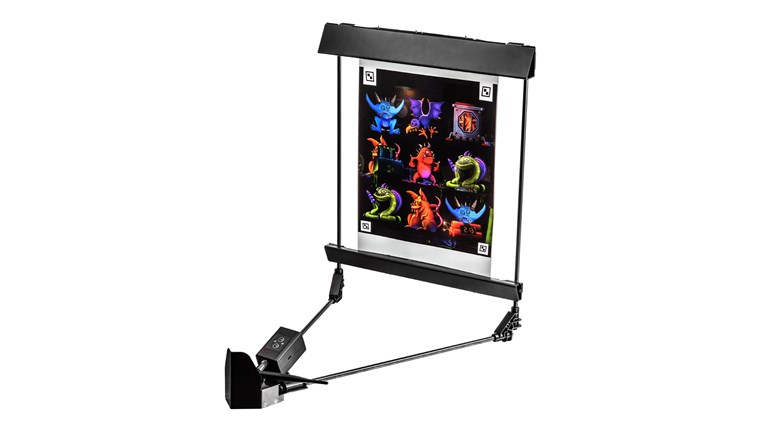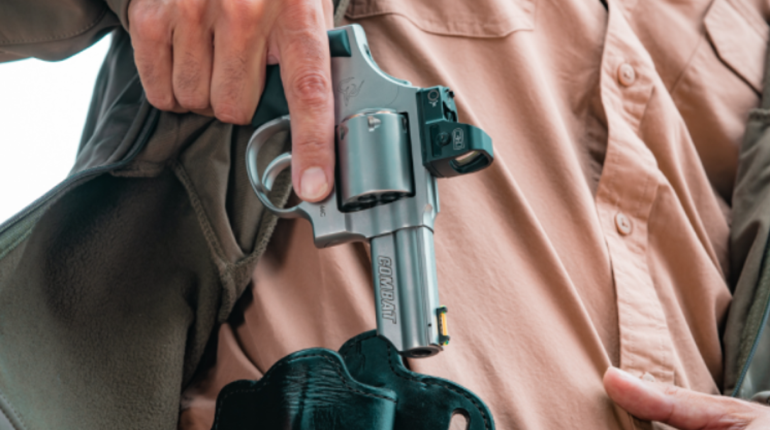
Have you ever wondered why most AR-15-style carbines shipped with an attachment on the barrel use a birdcage-type flash hider? They do look very cool, which is a big marketing factor since flash hiders are used by the military, and a lot of AR buyers are trying to emulate the military's choice in firearms. But, the main reason is economics. They are inexpensive compared to a lot of other accessories that fit a threaded muzzle. They are also useless.
A flash hider makes sense for military personnel because they are designed to help hide muzzle flash from the enemy during a firefight. If the bad guys can see the flash, they can direct fire at the good guys. If you stay hidden, you have the advantage. They also help when using night-vision equipment because they reduce the chances of the flash temporarily compromising a soldier's vision.
But civilians don't use rifles that way. We don't fight long battles with armed bad guys. Most of the civilian self-defense shootings are over in a few seconds and with few shots, so a flash hider really serves no purpose for those of us not wearing a uniform and fighting for the good of mankind.
So, why not pick performance over style and replace that flash hider on your rifle with something that will give you a tactical advantage for civilian use? If there is a simple-to-install product that will enhance the performance of your rifle—while still looking very cool—don't you think it is a good idea? Something that will make you faster in a fight, boost your scores in competition and help you beat your buddies like a rented mule in friendly weekend shoot-offs would be a welcome addition to your AR-15, right?
Perhaps it's time to take the approach of every serious action-shooting competitor and add a muzzle brake or compensator to your rifle. Action shooting is designed to simulate combat or self-defense situations, and the reason winning shooters all use muzzle brakes is they provide a huge advantage.
There is some argument a compensator helps reduce muzzle rise and a brake reduces recoil. Both terms seem to apply to these devices and they are used interchangeably here and in the marketplace.
The concept is simple: These devices redirect some of the escaping gas as it exits the muzzle, harnessing the energy to counter motion that is created by recoil. In theory, if the gas is directed up, the jet forces would push down on the muzzle and counteract muzzle flip. Also, if some of the gas were to slam into a wall or plate it would push the gun forward and reduce the felt recoil. Combine the two, and it provides a huge advantage when shooting the rifle.
Of course, brakes are a bit more complex, as the gas needs a path to escape and the physics can get complicated. So, there are top ports, single ports, multiple ports, side ports and even ports out the front of the brake, depending on brand and design. Some of the ports are built to trap the brake between opposing forces, which helps reduce movement and dampen barrel vibration. Rather than a top port, some brakes use a bottom shelf acted on by the gas to push down on the brake. The baffles—or front plates—will have a hole for the bullet to pass through, but as the gases expand they will contact it and push forward. The gasses then follow the bullet through the hole in the center, continue to expand and contact the second baffle, and sometimes even a third baffle. Depending on the brake design, it may use a combination of any or all of these features.
There are many different designs and theories about how to accomplish the objectives. Paraphrasing one maker, muzzle brake designs are like armpits and opinions, everybody has one and they all stink, except mine. In my experience, they all work—at least those I tested. Of course, some work better than others, but even that conclusion is a bit subjective. In my rather small circle of shooting buddies, there is a lot of disagreement on which brake actually works best. I think a lot of it comes down to shooting style and personal preference.
Why, you might ask, do you need a muzzle brake with a light-recoiling cartridge like the .223 Rem.? It is very simple: for the next shot. Even the mild recoil and muzzle flip of the .223 will cause sights to move off the target. But, with a well-tuned brake and proper shooting technique, the sights stay on target. Or at least, they move less distance off the target. In fact, the .223 Rem. is uniquely qualified for this concept. It's the most popular cartridge for AR-type rifles used for competition and self-defense, yet it is small enough to react very well to the application of a muzzle brake. Bigger, more powerful cartridges can be aided by a brake, but still generate enough recoil to move sights off target. But, the .223 Rem. can be tamed down even more with a well-designed brake and good shooting technique to keep the sights on target after the shot. This allows you to witness the hit and positions you for rapid follow-up shots. While conducting the shooting tests outlined here, the difference in the same rifle with and without a brake was shocking for all the shooters. Doing a side-by-side comparison will convince anyone of a brake's value.
Most 3-gun competition shooting requires two shots—or a double tap—on each target. If you have to spend time bringing the gun out of recoil and back on target, the second shot is delayed. But, with a brake, the sights stay on the target. I found that with a relatively close target, my biggest problem was my brain. It wants my eye to see the sights on the target before firing each shot. But, if I override it and simply pull the trigger twice, as fast as I can, both shots will hit the target.
Even if you are not a competitive shooter, a muzzle brake will help make you a better shot. That might be important for recreational shooting and it will certainly be applicable for home defense.
The concept of a double tap came from the fighting side and it makes good tactical sense in most situations. I have a friend who was in the South African special forces for many years, and he told me they always used a double tap in battle. The insurance of a second shot can be a lifesaver.
Brake OptionsWith the number of companies now making muzzle brakes/compensators, no list could ever be complete. But, here are some the author has been using.
Bushmaster(800) 998-7928, www.bushmaster.com
The Y COMP Muzzle Brake is offered in two lengths. I have the 25⁄16-inch Mini Y Comp on my Bushmaster piston gun.MSRP: $48.95
DPMS(320) 258-4448, www.dpmsinc.com
With six opposing side ports, the DPMS Miculek Compensator directs gasses outward to reduce muzzle jump. It was designed by Jerry Miculek, one of the top 3-gun shooters in the world.MSRP: $49.95
Dreadnaught Industries(210) 601-8149, www.dreadnaught-industries.com
The F2 AR15 Compensator is big by design. It measures 1 inch by 3 inches, the largest dimensions possible under USPSA Limited and Tactical rules. The idea is the more space used, the more performance gained.MSRP: $99.95
JP Enterprises(651) 426-9196, www.jprifles.com
Big and wild is the only way to describe the JP Recoil Eliminator. While it's not legal for Tactical Class 3-gun competition because it's too big, you will see a lot of them on the open-class guns. These are the shooters who can pick anything they want and they pick this brake. That makes a statement.MSRP: $99.95
The JP Enterprises Bennie Cooley Signature Series Tactical Compensator is legal for all classes in 3-gun shooting. This is the brake I currently have on my DPMS competition rifle.MSRP: $89.95
Nordic Components(320) 234-6015, www.nordiccomp.com
The smallest compensator I have come across is the NC Tactical Compensator. It's less than 2 inches long and adds less than 1 inch in overall length. This compensator fits very well on my DPMS AP4 Carbine, matching the contour of the barrel nicely. Despite its small size, it does a very good job of reducing muzzle lift and recoil.MSRP: $39.95
Primary Weapons Systems(208) 344-5217, www.primaryweapons.com
Designed by Dave Neth, who is one of the top 3-gun shooters in the world and a genuinely nice guy, the Dave Neth Compensator DNTC is small. It's only 2-inches long, but effective. For a great demo, go to the company's website and watch the video demonstrating shooting a full auto with a birdcage and then with this compensator. The difference is remarkable.MSRP: $69.95
SureFire(800) 828-8809, www.surefire.com
Surefire not only makes flashlights, it makes muzzle brakes designed to work alone as a muzzle brake and also as an attachment device for a sound suppressor. I have this brake on a Smith & Wesson M&P15 rifle. It's a bit unconventional looking, but the MB556AR Muzzle Brake/Adapter is a very effective brake.MSRP: $139
If you are not double tapping, a brake still gives you a lot more control for the next shot. I have found when shooting plates, or a dueling tree where it is one shot on each target, a brake allows much more control of the rifle and makes moving sights to the next target much quicker. I even found an advantage for long-range shooting. If the scope magnification is high, the brake allows the shooter to witness bullet strike. Also, as distance increases, the movement to bring the sights off target is more pronounced, especially with a high-magnification scope. So a brake provides a tactical advantage in any long-range scenario, including battling insurgent prairie dogs.Because the bullet has exited the barrel and is someplace down range before any of the magic happens in the brake, accuracy is unaffected. In fact, I think a brake will actually aid in accuracy by dampening harmonic vibrations in the barrel. To be honest, I have not done an accuracy test under controlled conditions to prove it, but invariably the most accurate AR barrels I have all wear muzzle brakes. My lighter-contour-barrel rifles that have brakes usually shoot better than bull barrel rifles with-out one.
In all honesty, there is no free lunch and there is a small price to pay in increased noise and muzzle blast, particularly for those who are to the sides of the shooter. But, only a fool shoots for practice or competition without ear protection. And in a fight for my life, I'll trade a pair of ringing ears for a chance to experience old age.
InstallationInstalling a muzzle brake is easy. Most rifles made after the "Assault Weapons Ban" expired have 1⁄2x28TPI threads on the end of their barrel. Guns made during the 10-year period when our government decided 1⁄2-inch, 28 threads-per-inch size was evil may have a different size and pitch thread. But don't despair if you have a post-ban rifle. There are brakes made in just about all the popular thread sizes, as well as adapters to convert some of them to 1⁄2x28 TPI.
The flash hider will have flats for an open-end wrench. Hold the rifle securely. The best approach is to clamp the barrel in a barrel vise, or a padded jaw vise, but usually lying the gun flat on the bench with a strong man holding it while another turns the wrench will work. Unscrew the flash hider. If it resists, it could be held on with thread locker and you may need to heat it to get it off.
The new muzzle brake should come with either a crush/peel washer or a jam nut. It is important for the brake to be oriented correctly. There will be a top and it must be aligned perfectly with the top-center of the barrel.A crush washer will collapse or crush as you tighten against it, allowing you to turn the brake into the correct alignment. With the peel washer, you try the fit and then peel off layers of the washer until the thickness is such that it allows the correct orientation of the brake when it is properly tightened. With a jam nut, you align the brake and then tighten the jam nut against the brake. When installing a brake, I like to coat the threads with blue (No. 242) Loctite for a little insurance, but not until after final tuning.
ClockingWhen you shoot the rifle you may find it is kicking to one side or the other. You can often correct this by clocking the brake. That is, to turn the brake a little off center to counteract side forces. This takes a bit of experimenting to find the exact position. Once you do, make a small witness mark on both the brake and the barrel with a felt marking pen so you can return to the exact same location. Then remove the brake, apply the Loctite and reinstall the brake.
You'll Never Go BackYou may decide to keep your old flash hider as a reminder that performance is more important than style, but don't expect to ever have the urge to put it back on your rifle. Once you start shooting with a brake you will never go back to useless barrel adornments.
One more thing, and this one can help pay for the brake. There's no reason to tell any of your buddies about the changes on your rifle until after you set the wager terms for next weekend's, winner-take-all shooting match.
Brake TestI ran two shooting tests to see if we could record the effectiveness of the brake, using three shooters with three different skill levels for each test.
The first test was three paper targets at 20 yards. The shooter starts with the rifle on his shoulder and the muzzle pointed down. At the buzzer he fires a double-tap at each target. We repeated this five times each, with a brake and without. Time is measured from the buzzer to the last shot. Score is from the scoring rings on a Shoot-N-C 17-inch bullseye target. This target simulates the kill-zone of a bad guy, while allowing a method to score hits. Scoring rings were face value and X hits were counted as eleven. The test gun was a DPMS AP4 Carbine that was equipped with a JP Bennie Cooley Brake. This gun was also fitted with a JP trigger and a Leupold CQ/B scope.
The second test was to shoot at an Action Targets PT Hostage Target at 200 yards. This target is a steel version of the standard IPSC target. Hits were identified by an observer using a Swarovski spotting scope. A hit anywhere on the target counted.The challenge was to hit the target five times in succession. The shooter started lying prone with the gun on target and shooting started at the buzzer. We repeated this evaluation three times. Again, we used three shooters with different skill levels. Shooters 1 and 2 also participated in the first test, while 3 was a different shooter.
The rifle in this test was a Smith & Wesson M&P15 with a SureFire brake. This gun was equipped with a Timney trigger and a Burris 1-4 XRT Tactical scope.
Test One| With Brake | Without Brake | |||
| Shooter | Time | Score | Time | Score |
| 1 | 3.33 | 9.67 | 4.63 | 9.85 |
| 2 | 4.25 | 9.92 | 4.42 | 10.08 |
| 3 | 5.45 | 8.32 | 5.50 | 9.26 |
Time is in seconds. Of note is the fact that scores were not significantly altered by shooting with or without the brake.
Test Two| With Brake | Without Brake | |||
| Shooter | Time | Score | Time | Score |
| 1 | 4.4 | 5.0 | 6.34 | 5.7 |
| 2* | 5.78 | 5.7 | 6.63 | 6.0 |
| 3 | 8.92 | 5.3 | 22.58 | 10.33 |
Time measured in seconds. All shooters saw not only a significant increase in time, but also more misses after removing the brake during the 200-yard test. *Shooter had one bad run far outside his abilities that skewed the results—if we throw out that run, time is 4.42 and shots 5.0.




































